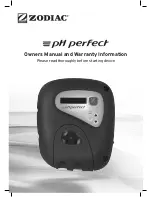
12
POOL MAINTENANCE
POOL WATER CARE
1. Check and adjust pH and chlorine levels daily using required chemicals. See Section “POOL WATER CARE”.
2. Check filter pump output daily. If flow is reduced, see Symptom 2 in Section “TROUBLESHOOTING GUIDE”.
3. Check filter pump, hoses, fitting for leaks. If a leak is found, see Symptom 4 in Section “TROUBLESHOOTING GUIDE”.
4. Run the pump for the recommended number of hours daily. If you are unsure of the time frame please refer to support.polygroupstore.com for the recommended
"Pump Operation Hours" bases on pool types and sizes.
5. Once finished cleaning, liberally lubricate the Canister Gasket
p
with petroleum jelly.
6. Reassemble the parts in reverse order. Before restarting your Pump, make sure that you've removed the SF Cap
5
and RF Plug
f
.
7. Suntan oils, body oils and algae can quickly build up and clog the pleats of the Cartridge, reducing the filtration efficiency. Therefore, it is imperative to remove such
films of oils and/or algae.
To remove oils:
mix 1 pound of trisodium phosphate (TSP or any other strong detergent) and 5 gallons of water, and soak the Cartridge for 12 hours.
To remove oils AND algae:
same as above, and add ½ pint of pool chlorine or 1 pint of liquid household bleach to the solution ONE HOUR BEFORE removing
the Cartridge from the solution.
Thoroughly rinse the Cartridge before reusing it.
8. Excessive calcium and/or mineral deposits may build up on a filter cartridge and should be handled differently. Contact your local pool supply store to ask about
additional filter cartridge cleaners or treatment for calcium or mineral deposits. Check pool chemistry for high pH or alkalinity; this may cause a calcium or mineral
build-up.
9. A spare “stand-by” Filter Cartridge
s
is an excellent investment. It provides a convenient way to continue filtration of your pool while cleaning or replacing a dirty
Filter Cartridge
s
. Also, a well-maintained, clean cartridge assures you that your filter will always be ready to operate at peak efficiency.
10. Filter cartridges may be purchased at the store you purchased your pool from, or ordered from BLUE WAVEat polygroupstore.com. Always replace with genuine
BLUE WAVE filter cartridges.
1. The following items are required to get your pool ready for use. They are available at polygroupstore.com or your local pool supplies stores:
a.
Test kit
– for checking the chlorine and pH levels of the pool water
b.
Floating chlorine dispenser (not included) and chlorine tablet
– for water disinfection and prevention of the growth of algae
c.
pH control chemicals
– for adjusting the pH level up (soda ash) or down (acid)
d.
Algaecides
– to eliminate algae
e.
Superchlorinator
– to destroy (“shock”) the combined chlorine, ammonia, nitrogen, and organic compounds that build up in pool water over time and with
extended use
f.
Leaf net with handle
– for removing leaves, trash, insects, etc. from the pool
2.
IMPORTANT:
it is a
MUST
to maintain the chlorine and pH levels at all times:
a. Check and adjust the pH and chlorine levels daily. FILTER PUMP ALONE WILL NOT PREVENT ALGAE FROM GROWING IN POOL WATER; THIS CAN ONLY
BE DONE BY MAINTAINING PROPER CHLORINE AND pH LEVELS AT ALL TIMES.
b.
Recommended pH level:
between 7.3 and 7.8
c.
Recommended chlorine level:
between 1.0 and 1.6 ppm
d. Superchlorinate your pool at least every other week.
e. Hot weather and heavy use may require the pH and chlorine levels to be maintained on the upper side of the scale as well as a weekly superchlorination.
f. Using a pool and/or solar cover will help maintain the pH and chlorine levels by reducing evaporation of pool water.
g.
CAUTION:
High chlorine concentration and low pH level will damage the pool/pool liner. You must follow the instructions on quantity and safe usage of the pool
chemicals you use.
NEVER
drop lumps or pellets of chemicals into the pool – this may present a hazard to the swimmers and/or damage your pool liner.
3. Clean your pool regularly using a maintenance kit with vacuum. You can get the kit from
polygroupstore.com
4. Using a foot bath prior to entering the pool will help keep the pool clean.
5. Avoid using well water. If you must use well water, always seek professional advice from your local pool chemical suppliers before chemicals into it.
6. Find out the water capacity (in gallon) of your pool from the pool Owner’s Manual. You will need it to determine the amount of chemicals required, or when you
contact a pool supplies expert for water testing and advice on safe use of chemicals.
NOTE:
Always follow the manufacturer label directions of the chemicals you choose to use.













































